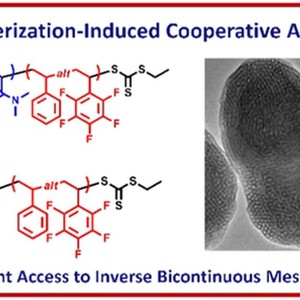Efficient Access to Inverse Bicontinuous Mesophases via Polymerization-Induced Cooperative Assembly
Citation
Fei Lv, Zesheng An*, and Peiyi Wu*. Efficient Access to Inverse Bicontinuous Mesophases Via Polymerization-Induced Cooperative Assembly. CCS Chem. 2020, 3, 2211-2222.
Abstract
Polymerization-induced cooperative assembly (PICA) is reported to efficiently access inverse bicontinuous mesophases within particles consisting of amphiphilic block copolymers (BCPs) and solvophobic copolymers. Reversible addition-fragmentation chain transfer (RAFT) dispersion alternating copolymerization of styrene and pentafluorostyrene is conducted in 2% v/v toluene/ethanol by simultaneously using poly(N,N-dimethylacrylamide) (PDMA29) as a macromolecular chain transfer agent (macro-CTA) and small molecule CTA. The polymerization kinetics of PICA and polymerization-induced self-assembly (PISA) were compared, and the apparent rate constants observed in both systems were essentially the same. Gel permeation chromatography (GPC) indicated that PICA-synthesized amphiphilic BCPs/solvophobic copolymers had low dispersity. PICA syntheses were conducted by systematically varying the degree of polymerization of the core-forming block/solvophobic copolymer at different CTA molar ratios (x) and solid contents. The particle morphology was investigated by transmission electron microscopy (TEM), scanning electron microscopy (SEM), and small-angle X-ray scattering (SAXS). Inverse bicontinuous mesophases could be accessed at different x and solid contents, demonstrating that PICA promoted the formation of inverse bicontinuous mesophases more effectively, compared with PISA.


